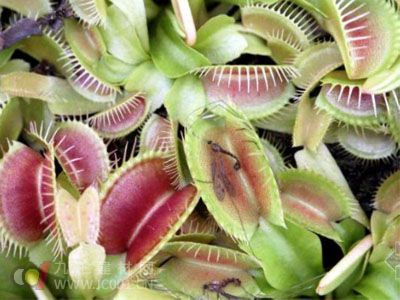Methods of Breeding Flytraps:
Sexual Reproduction: The Venus flytrap can self-pollinate, but it's usually done through artificial pollination. However, this process isn't always successful because timing is crucial. When the flower opens, the stamens mature first, while the pistil lags behind by about a day. Pollinating too early won’t work, as the stigma of an immature pistil is round, whereas a mature one splits into small lobes. Only when the stigma is split can successful pollination occur.
If pollination is successful, the flower will wither within 1–2 days, and the ovary at the base of the pistil will begin to swell. After several weeks, the fruit matures. Each fruit typically contains more than a dozen black, oblong seeds. The number of seeds depends on the plant’s health and size—stronger plants tend to produce more. Sometimes, even with correct pollination, no seeds may appear due to weak plants or insufficient light during flowering. Even if pollination is successful, the plant might not bear seeds if it lacks strength.

Venus flytrap seeds don’t last long, so it's best to sow them as soon as they're harvested. If you want to cross different plants but they bloom at different times, you can collect and store pollen in the fridge to extend its viability.
Flowering uses a lot of energy. If you don’t need the plant to flower, especially when aiming for a large strain, it's better to remove the stems early to prevent nutrient loss. Some weakened plants may still flower, but cutting the stems helps preserve their strength.
Asexual Reproduction:
Leaf Cuttings: One of the most common methods for propagating Venus flytraps is leaf cuttings. In spring and early summer, when the plant is actively growing, you can take a petiole (the stem-like part of the leaf) and insert it into the soil. The leaf itself is attached to the petiole, which should be placed on a moist medium under bright light. After a few weeks, new shoots may appear.
This process is slow, so patience is key. As long as the petiole doesn’t rot or turn black, keep it in the right conditions. High humidity and indirect light are essential. Direct sunlight can dry out the petiole and harm the process.
The age of the petiole also affects success. Younger or older leaves have lower chances of producing new plants. Use healthy, mature petioles for the best results. If the petiole already has roots, the chances of success increase significantly.
To avoid rot, use a clean growing medium. Sphagnum moss is ideal for leaf cuttings. Once the seedling grows, you can transplant it to another location.
Ramets: Venus flytraps often develop side buds. When these buds grow large enough with proper roots, they can be separated from the parent plant and grown independently. However, some cultivated varieties rarely produce these buds.
Flower Bud Propagation: Interestingly, sometimes the flower buds of a Venus flytrap can develop into new plants. This phenomenon occurs due to temperature fluctuations between day and night. If the temperature difference is significant, the flower bud may transform into a small plant. You can then cut it off and plant it to grow a new flytrap.
Grey Color Self Adhesive Car Roll Film
Grey Color Self Adhesive Car Roll Film,Gray Color Privacy Film,Car Tinting Film,Outdoor Smart Car Film
Shenzhen YuGuang New Material Co.,Ltd , https://www.ygsmartfilm.com